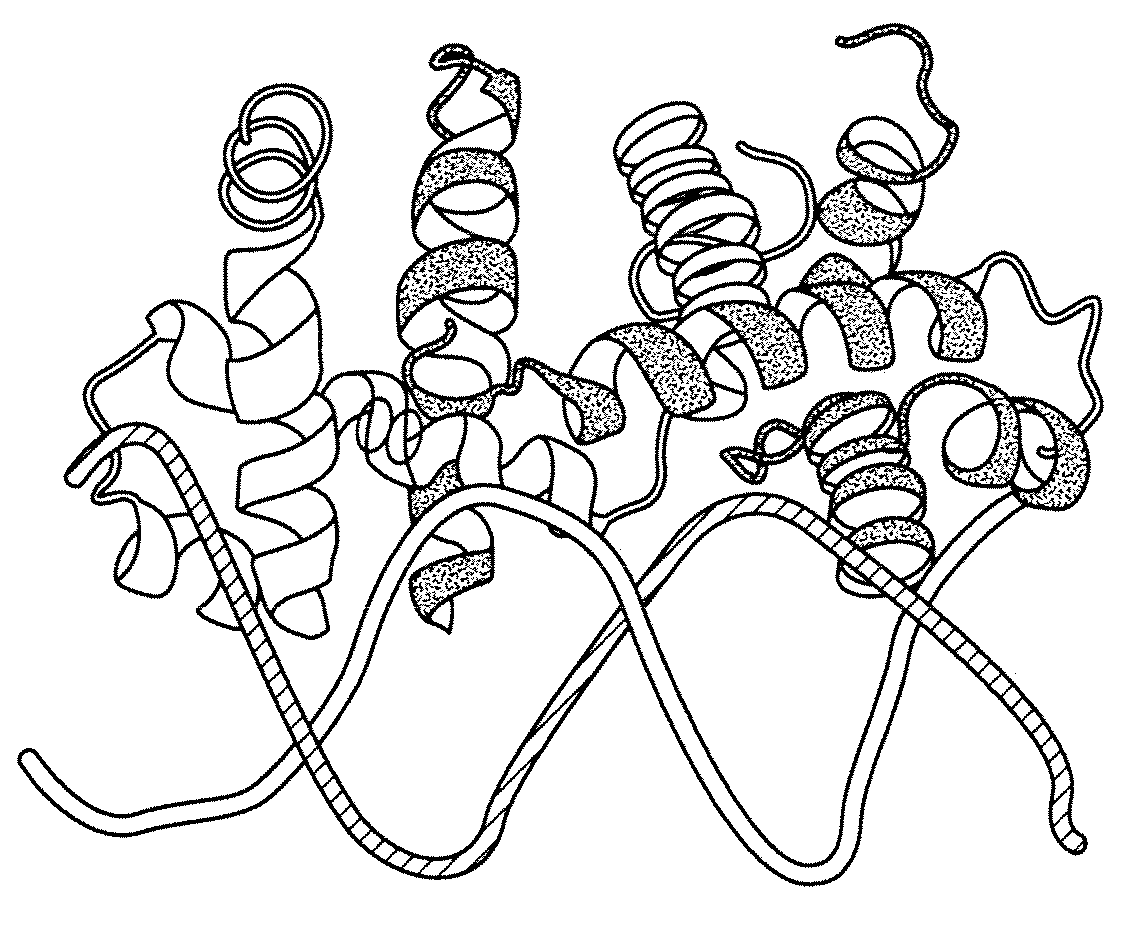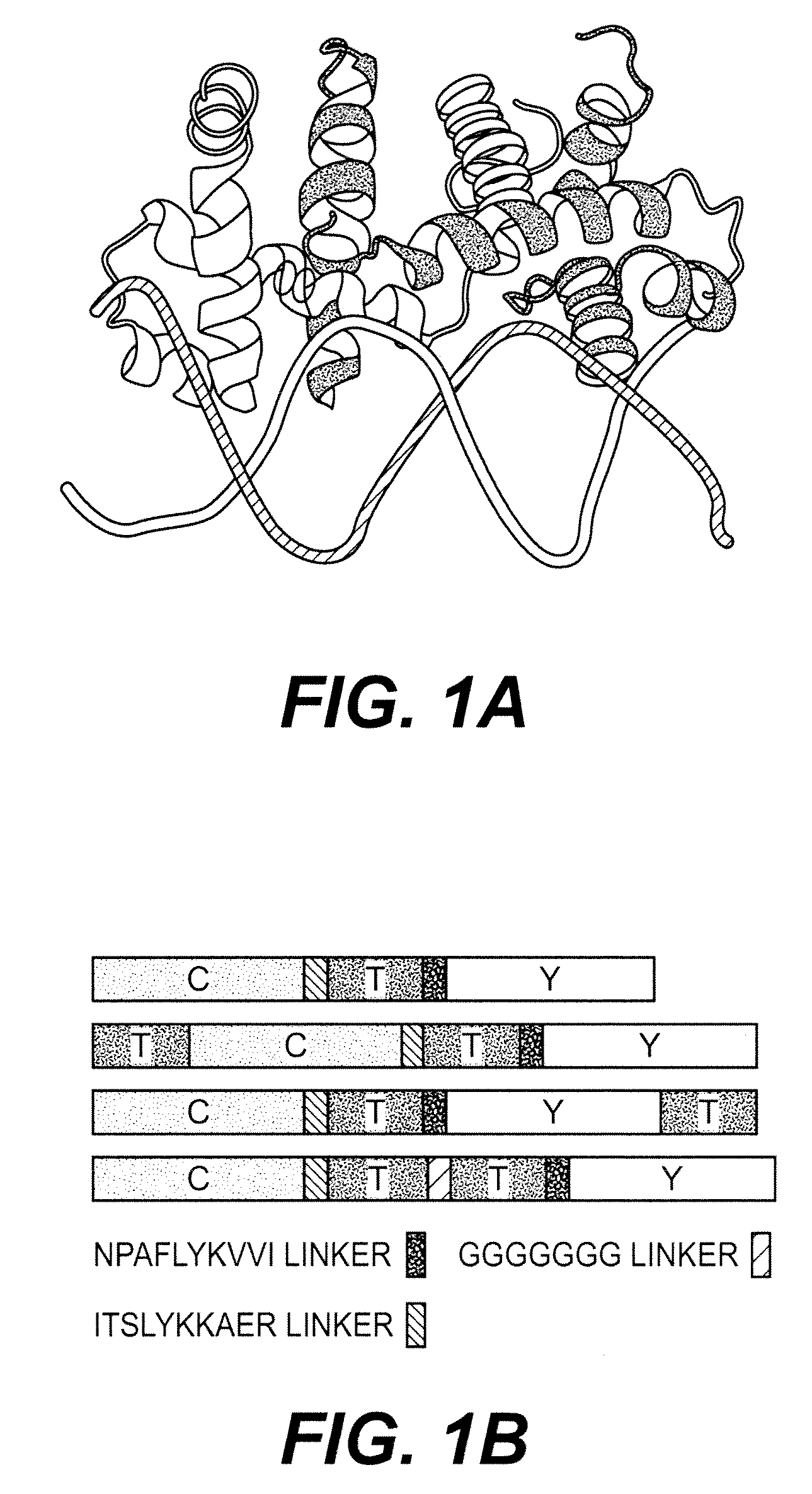TRP/HIS Exchange and Kynurenine Induced TRP Transport
a kynurenine-induced, trp/his exchange technology, applied in the field of trp/his exchange and kynurenine-induced trp transport, can solve the problems of lack of high temporal or cellular/subcellular resolution, no tryptophan-binding pbps have been described, and neither time-resolved nor specific methods, etc., to achieve the effect of suppressing t cell activity, increasing kynurenine level
- Summary
- Abstract
- Description
- Claims
- Application Information
AI Technical Summary
Benefits of technology
Problems solved by technology
Method used
Image
Examples
example 1
A Ligand-Binding Scaffold for L-Tryptophan
[0183]The E. coli tryptophan operon repressor TrpR is an all-helical polypeptide of 108 amino acids organized into 6 α-helices. This polypeptide forms a dimer that selectively binds two molecules of L-tryptophan with micromolar affinity (FIG. 1A) (Marmorstein et al., 1987). In the active, dimeric conformation of TrpR, 5 of the 6 helices in each polypeptide are involved in intermolecular contacts (Schevitz et al., 1985). With both chains contributing to each tryptophan-binding site, two TrpR polypeptides are necessary to form two functional intermolecular binding sites (FIG. 1A). In the absence of tryptophan, a part of TrpR is unfolded (Reedstrom and Royer, 1995), which likely corresponds to the helix-turn-helix motifs that form the ‘DNA-reading heads.’ Crystallographic analysis shows that the helix-turn-helix motif undergoes structural rearrangements upon binding of tryptophan (Zhang et al., 1987), and the motif's flexibility is essential fo...
example 2
Twin-Cassette FLIPW Nanosensor Variants
[0184]The active conformation of TrpR is a dimer and two tryptophan binding sites are formed at the dimer interface (Otwinowski et al., 1988). Therefore, one assumes that the functional FLIPW-CTY sensor is a dimer of two CTY polypeptides with the four fluorophores being packed tightly together, potentially affecting the binding affinity due to steric hindrance or resulting in signal loss due to averaging of the fluorophore signals. Thus, fusing two TrpR molecules to one fluorophore set likely gives rise to sensors with a single eCFP-Venus pair per sensor, which may have improved sensing characteristics. Three sensor permutations containing two TrpR copies (a and b) in a single gene product were constructed (FIG. 1B). In the permutants FLIPW-TCTY (linear arrangement of TrpRa-eCFP-TrpRb-Venus) and FLIPW-CTYT (linear arrangement of eCFP-TrpRa-Venus-TrpRb) the distance between the N- and C-terminus of the intercalated green fluorescent protein vari...
example 3
Molecular Modeling of FLIPW Sensors
[0186]Molecular modeling was performed to rationalize the observed FRET signal changes. The original sensor, FLIPW-CTY, is predicted to dimerize, resulting in an antiparallel arrangement of the TrpR polypeptides, thus resulting in two sets of eCFP and Venus fluorophores in close vicinity at both sides of the TrpR dimer (FIG. 2A). In agreement with the close vicinity of the fluorophores, FLIPW-CTY showed the highest FRET efficiency. The FLIPW-CTYT sensor is modeled to form a functional TrpR dimer intra-molecularly, resulting in a single eCFP and a single Venus molecule per sensor (FIG. 2B). FLIPW-CTYT has lower absolute energy transfer efficiency, consistent with the greater distance between the fluorophore dipoles. The relative FRET change is higher compared to FLIPW-CTY, probably due to the rigidification of the Venus molecule by its fusion to both TrpR monomers. The FLIPW-CTTY and FLIPW-TCTY sensors do not show sufficient ligand-dependent ratio c...
PUM
| Property | Measurement | Unit |
|---|---|---|
| Tm | aaaaa | aaaaa |
| temperature | aaaaa | aaaaa |
| temperature | aaaaa | aaaaa |
Abstract
Description
Claims
Application Information
 Login to View More
Login to View More - R&D
- Intellectual Property
- Life Sciences
- Materials
- Tech Scout
- Unparalleled Data Quality
- Higher Quality Content
- 60% Fewer Hallucinations
Browse by: Latest US Patents, China's latest patents, Technical Efficacy Thesaurus, Application Domain, Technology Topic, Popular Technical Reports.
© 2025 PatSnap. All rights reserved.Legal|Privacy policy|Modern Slavery Act Transparency Statement|Sitemap|About US| Contact US: help@patsnap.com



